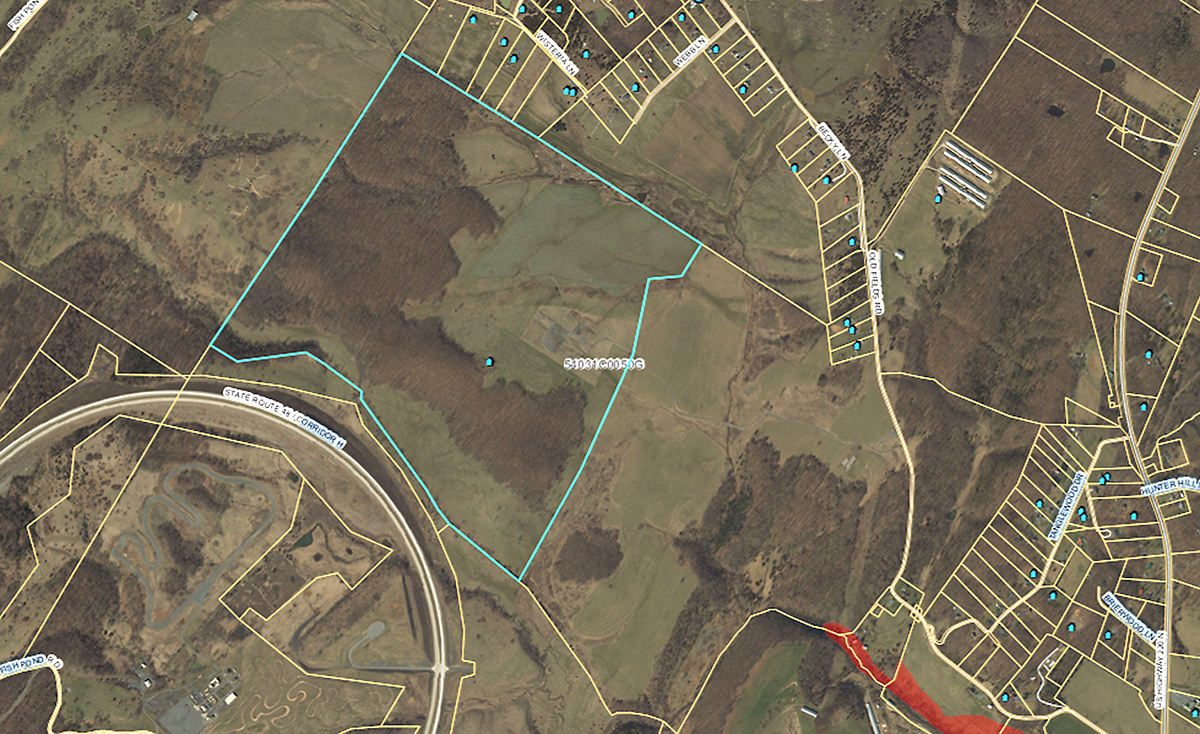By Lon Anderson
Moorefield Examiner
Citizens living near the 20-poultry house development now underway in Old Fields turned out in force at the June meeting of the Hardy County Planning Commission to ask questions and get answers. As it turned out, they had more questions than the Commission had answers.
Meeting at an open-air shelter at Brighton Park on June 23 in response to Covid-19 pandemic, the Commissioners heard from about 15 very concerned and frustrated residents from in and around the Becky Webb subdivision. The development is adjacent to the 95-acre tract where work is already underway. The $10 million, 20-broiler house complex has been described as a “mega poultry project” that might be the largest of its kind in West Virginia.
“This is a big crowd for us,” quipped Commission President Lee Lehman after looking down the long tables at all of the visitors. “Usually it’s just us (Commission Members and staff) and the Examiner.”
Top concerns mentioned by those living near the “mega poultry complex” focused on impacts to the environment including water and air as well as damage to their property values because of the complex.
The Planning Office issued a building permit for the project in February, and the project developer, Robert Williams, who is also a member of the Planning Commission, has received the other necessary permits from the State Departments of Environmental Protection (DEP) and Division of Highways, and is proceeding with construction.[private]
Planning Office Administrative Assistant Nicole Rohrbaugh told the meeting that, based upon multiple inquiries, there “was some misunderstanding that the Commission had to approve the permit,” and explained it was approved administratively in the Planning Office.
“I want to clear up this,” said Commission President Lee Lehman. “This Board did not meet and approve any poultry houses. The code allows poultry houses in an Ag zone.”
In fact, the Planning Commission, by ordinance, is solely in an advisory role to the County Commission with no authority to pass zoning ordinances or take any final actions. All actions of the Planning Commission are recommendations that must be approved by the County Commissioners to be enacted.
Resident Angela Zirk noted that there are actually three subdivisions impacted (by the project) and they all support the Ag community.
“Our concern is what are the effects,” she said, noting that there are 37 homes with 89 folks that the project directly affects, and “we are trying to understand this. The water supply for example: where is it coming from?”
“Based upon current permits, it will be from wells,” Rohrbaugh explained. “And the state does not require ground water studies for that.”
“But there should have been something (examining that)” responded property owner Jeremy Baldwin. “What if our wells go dry?”
“I’m working downstream and I’m concerned about this,” said Planning Commission Member George Leatherman, also an Old Fields resident. “In retrospect, we should require studies to be done. The whole purpose of zoning is to protect property values.”
“The whole concept of 20 large chicken houses on one site is a pretty new thing,” Lehman noted, admitting that it was not something the Planning Commission had considered in its work on the County’s Comprehensive Land Use Plan.
Kirk Wilson, an engineer with L&W enterprises who is involved with the project, noted that “DEP only issues permits to prevent flooding – that’s what the State requires. It also limits withdrawals of surface water streams to about 10% of the flow. There isn’t a great deal of regulation of groundwater in West Virginia.”
“What’s Pilgrim’s say in this?” asked resident Steve Pendleton. “That’s a lot of their birds if the wells go dry.”
“How is a facility this large going to affect our wells?” asked resident Stacie Thompson.
“That’s the great unknown question,” responded Rohrbaugh.
“It sounds like things approved by the Planning Commission and the County Commission take no consideration of the impacts on us,” said resident Lloyd Fultz, Jr. “We have lots of workers coming in (to build the chicken houses) – who are they? Where do they come from?”
“We want people to come here and live here,” he continued. “But chickens are ruining Hardy County. It’s our property values now, but it could be yours next. You need to update this so it doesn’t happen to you in the future.”
“That’s exactly what Ben (Martin, Planning staff) is doing to help us update the Comp Plan,” explained Commission Vice President Greg Greenwalt. “That data will be the basis for future zoning. The code requires us to do this every ten years.”
The process, he continued, “provides numerous opportunities for public input.”
“And 2021 is our date for having the Comp Plan updated,” Lehman explained. “Everybody’s going to get an opportunity (to participate) during this process.”
The problem is, Lehman continued, “that when you are discussing what to do about a field full of dilapidated mobile homes, or regulating exotic entertainment, a couple hundred people will turn out for that, but few turn out for regulatory issues discussions. In fact, the norm is people don’t want land regulated.
“You are right. We need to make changes in this. I’m winding down (in this position) and I’d like something to happen sooner rather than later.”
Lehman then suggested that inclusion of size in what gets regulated might be a good way to differentiate. You could pick a size and anything that goes over that would have to get permitted—perhaps a conditional use permit. Then there would have to be a BZA (Board of
Zoning Appeals) hearing, and everyone would have to get written notice. What goes through the BZA now often has conditions put on it.
“A family farm and a Corporate entity should be treated the same—and could be if you based it upon square footage.”
“We are conscientiously trying to find language that works,” Greenwalt, the Commission’s Vice President, said. “It’s hard. It’s not easy to write something that stands up to all of the challenges.”
“As soon as you have a set of rules to go by,” Lehman added, “there’s going to be somebody who will try to go outside them.”
Another citizen wanted to know if there was anything that could be done to challenge the project.
“We’ve looked at this,” responded Jay Fansler, who serves on both the Planning Commission and the County Commission. “We talked to the prosecutor—there’s just nothing we can do. I think we have to look at size. This project –the number of birds–would be the same as adding 40 chicken houses just five years ago.”
Each of the 20 poultry houses could hold between 50,000-55,000 chickens, according to a local grower.
Rohrbaugh noted that the applicant “met all of the requirements under the Ag zone ordinance, so there’s nothing we can do—and we could possibly be sued for turning it down.”
So, noted resident Gerald Johnson, “You have no control over nothing now. How about working on a three-to-five-year plan?”
“We actually do updating that’s ongoing,” responded Greenwalt. “The thing we try to do is work on these things all along. But we need the public’s input, reminding the group that “we usually meet for about one hour, once a month. We are a bunch of volunteers doing the best we can.”
“I’ve been on the Commission since 1989,” Leatherman interjected. “People don’t pay any attention to what we do until it directly affects them. I’m ready to step down if someone here would like to take my place…”
Another resident wanted to know when the Commission learned of the project—”How did you not know this was coming?”
“We did not see this coming,” responded Greenwalt. “Not a 20-building complex.”
“We did not have notice of it until February,” Rohrbaugh confirmed.
“When the permit request came in for 20 houses, she (Melissa Scott the former Planning Manager) informed us,” Lehman confirmed, but noted again, there’s no action the Commission can take: “Our discussions now are about what to do with requests for 20 poultry houses in the future.”
“As flawed as it is (here)” Greenwalt noted referring to zoning in Hardy County, we are one of the few counties (in the state) with any zoning. Grant and Pendleton have none.”
Rohrbaugh explained that those counties only have a 100-foot setback, and that Hardy requires a 300-foot separation, providing homeowners some additional protection.
“What about the permit for burning?” asked another citizen. “Land-clearing fires have been going on for two weeks day and night,” and indicated that he didn’t think there was anyone watching the fires all night because he can see it from his house.
Other concerns raised by the residents near the project focused on air quality, both the odors from the houses and the dust from big truck activity. “I have asthma—what’s the impact going to be on me?” asked one.
Williams, the project developer, responded that he would look into the issue about the fires and also would try to provide some answers to many of the other questions raised.
In other Commission business, Lehman noted that three of the Commission’s members have terms that are expiring: Tyler Bradford, Greg Greenwalt and George Leatherman, and asked if they were willing to continue. All indicated they would, and Lehman then asked that a letter be prepared to the County Commission recommending the reappointment of all three.
Rohrbaugh also reported on the permitting activity of the Planning Office since their last meeting, indicating that: in March, 21 permits were issued with an estimated construction value of $1.689 million; in April, 21 permits were issued valued at $1.413 million; In May, 16 permits were issued, valued at $6.79 million, and in June, 23 permits were issue with a value of $1.349 million, and noted that June’s would likely go higher since there were still several days left in the month.
Lastly, the Commission also agreed that their next meeting would be held Wednesday, July 7, also at Brighton park at 6 pm.[/private]

